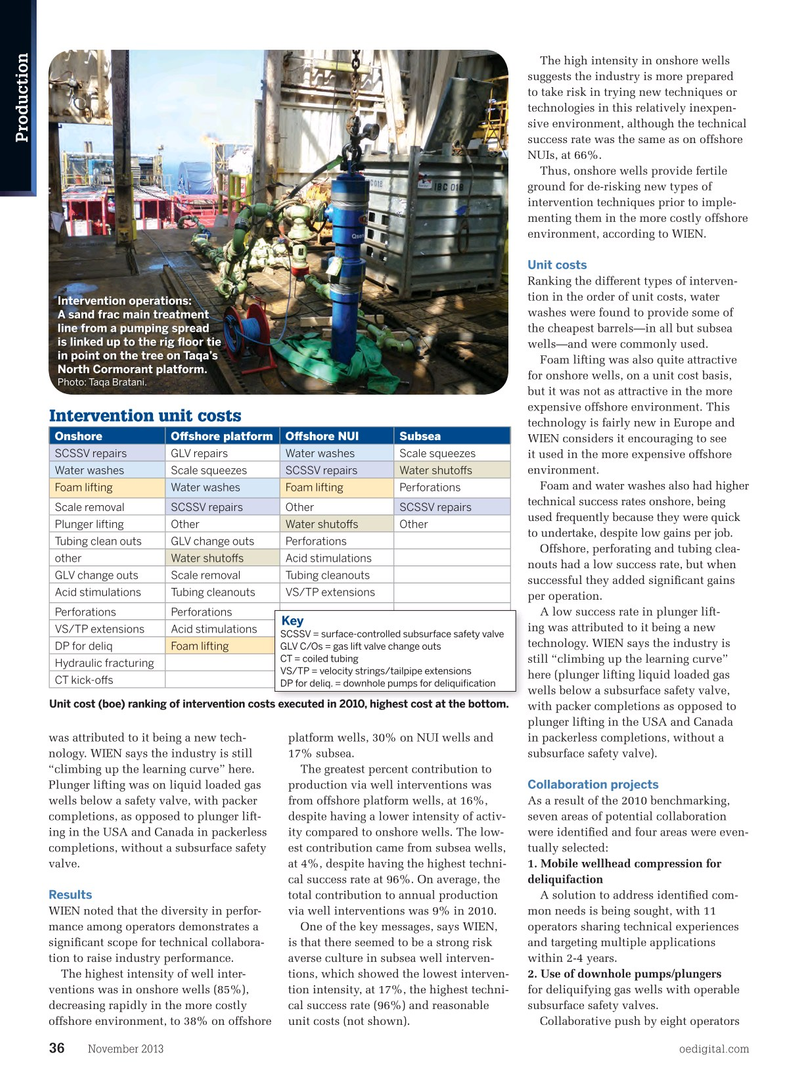
Page 34: of Offshore Engineer Magazine (Nov/Dec 2013)
Read this page in Pdf, Flash or Html5 edition of Nov/Dec 2013 Offshore Engineer Magazine
The high intensity in onshore wells suggests the industry is more prepared to take risk in trying new techniques or technologies in this relatively inexpen- sive environment, although the technical
Production success rate was the same as on offshore
NUIs, at 66%.
Thus, onshore wells provide fertile ground for de-risking new types of intervention techniques prior to imple- menting them in the more costly offshore environment, according to WIEN.
Unit costs
Ranking the different types of interven- tion in the order of unit costs, water
Intervention operations: washes were found to provide some of
A sand frac main treatment the cheapest barrels—in all but subsea line from a pumping spread is linked up to the rig foor tie wells—and were commonly used. in point on the tree on Taqa’s
Foam lifting was also quite attractive
North Cormorant platform. for onshore wells, on a unit cost basis,
Photo: Taqa Bratani.
but it was not as attractive in the more expensive offshore environment. This
Intervention unit costs technology is fairly new in Europe and
Onshore Ofshore platformOfshore NUI Subsea
WIEN considers it encouraging to see
SCSSV repairs GLV repairs Water washesScale squeezes it used in the more expensive offshore environment.
Water washesScale squeezes SCSSV repairs Water shutofs
Foam and water washes also had higher
Foam lifting Water washesFoam lifting Perforations technical success rates onshore, being
Scale removal SCSSV repairs Other SCSSV repairs used frequently because they were quick
Plunger liftingOther Water shutofsOther to undertake, despite low gains per job.
Tubing clean outsGLV change outsPerforations
Offshore, perforating and tubing clea- other Water shutofsAcid stimulations nouts had a low success rate, but when
GLV change outsScale removalTubing cleanouts successful they added signifcant gains
Acid stimulationsTubing cleanoutsVS/TP extensions per operation.
A low success rate in plunger lift-
PerforationsPerforations
Key ing was attributed to it being a new
VS/TP extensionsAcid stimulations
SCSSV = surface-controlled subsurface safety valve technology. WIEN says the industry is
GLV C/Os = gas lift valve change outs
DP for deliq Foam lifting
CT = coiled tubing still “climbing up the learning curve”
Hydraulic fracturing
VS/TP = velocity strings/tailpipe extensions here (plunger lifting liquid loaded gas
CT kick-ofs
DP for deliq. = downhole pumps for deliquifcation wells below a subsurface safety valve,
Unit cost (boe) ranking of intervention costs executed in 2010, highest cost at the bottom. with packer completions as opposed to plunger lifting in the USA and Canada was attributed to it being a new tech- platform wells, 30% on NUI wells and in packerless completions, without a nology. WIEN says the industry is still 17% subsea. subsurface safety valve). “climbing up the learning curve” here. The greatest percent contribution to
Collaboration projects
Plunger lifting was on liquid loaded gas production via well interventions was wells below a safety valve, with packer from offshore platform wells, at 16%, As a result of the 2010 benchmarking, completions, as opposed to plunger lift- despite having a lower intensity of activ- seven areas of potential collaboration ing in the USA and Canada in packerless ity compared to onshore wells. The low- were identifed and four areas were even- completions, without a subsurface safety est contribution came from subsea wells, tually selected: valve. at 4%, despite having the highest techni- 1. Mobile wellhead compression for cal success rate at 96%. On average, the deliquifaction
Results total contribution to annual production A solution to address identifed com-
WIEN noted that the diversity in perfor- via well interventions was 9% in 2010. mon needs is being sought, with 11 mance among operators demonstrates a One of the key messages, says WIEN, operators sharing technical experiences signifcant scope for technical collabora- is that there seemed to be a strong risk and targeting multiple applications tion to raise industry performance. averse culture in subsea well interven- within 2-4 years.
The highest intensity of well inter- tions, which showed the lowest interven- 2. Use of downhole pumps/plungers ventions was in onshore wells (85%), tion intensity, at 17%, the highest techni- for deliquifying gas wells with operable decreasing rapidly in the more costly cal success rate (96%) and reasonable subsurface safety valves.
offshore environment, to 38% on offshore unit costs (not shown). Collaborative push by eight operators
November 2013 oedigital.com 36 034_OE1113_ProdOps1.indd 36 10/28/13 1:37 AM

 33
33

 35
35